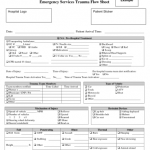Well, you’ve read me railing against the (current) use of an electronic medical record in place of a paper trauma flow sheet for days. I’d like to share some comments from an end user (nurse) who started using the Epic Trauma Navigator last year:
I am really not impressed with the Trauma Narrator for a few reasons:
- Bulky & cumbersome to access during a trauma team activation. Our build team promised us that this would be an efficient model of documentation, however, that has not been the case. It takes more steps to document than before and the output is in so many different places review of the chart is extremely difficult to do. You need to know exactly where to look for this information.
- While the rest of Epic has a feature that allows for the automatic integration of vital signs from cardiac and NIBP monitors, Epic does not allow this feature in the Trauma Narrator. All vitals need to be entered manually which can be time consuming. Knowing this up front, I think I would have advocated for not using the Trauma Narrator at all.
- Vital signs and GCS are not displayed within the same flowsheet in Epic. You can find VS in several places, however GCS are in one specific location and if you don’t have the secret treasure map to find them, you will be searching the high seas of frustration for a long period of time.
- During our build, there were several requests that were not included in the build. I am told that the once Epic goes live, there is a lock-out of up to 12 months before any “optimization” occurs. My advice to you all who are going to Epic is to be adamant about what you want and ensure it is there before go-live. We are missing small things like “logroll time” and level of activation among other “simple” items.
- Massive transfusions are difficult to document as you need to address each blood component separately and there are several steps in the process for each component. Again, not a user-friendly system at this point for that.
- Our training was done concurrently with our build so our training was on a generic template/flowsheet within the Epic playground that did not mirror our live version. This was not at all what our production/end-user system looked like at all, so our employees had to be retrained on the job on how to document with the Trauma Narrator.
- Order sets are available within Epic, however not all staff use the trauma order sets. This creates confusion and the incorrect items being ordered. Again, bird-dogging is required to assure compliance.
- Once the patient is “arrived” within the Epic system (aka patient chart is noted as the patient actually being in the ED) you cannot go back and document on the EMS radio/report sheet. Staff need to be diligent to assure that documentation is completed before the patient arrives. We have had scenarios where there have been multiple trauma patients arriving and once the nurse begins the documentation of the trauma team, the ED Charge nurse could not go back and enter the radio report in the proper section.
… remember, Epic is a documentation tool, and as a tool, it depends on the user. Some will continue to document incredibly well and others not so much.
Bottom line: I have absolutely nothing against Epic. I consider it to be one of the best EMRs out there, and I’ve been exposed to quite a few. As you can see though, even it suffers from many of the input problems I’ve written about in the past. And trauma flow products on other EMRs don’t even come close to this one. So for now, buyer beware! Wait until the input technologies and report capabilities become so intuitive that anyone can use them.
Related posts:

